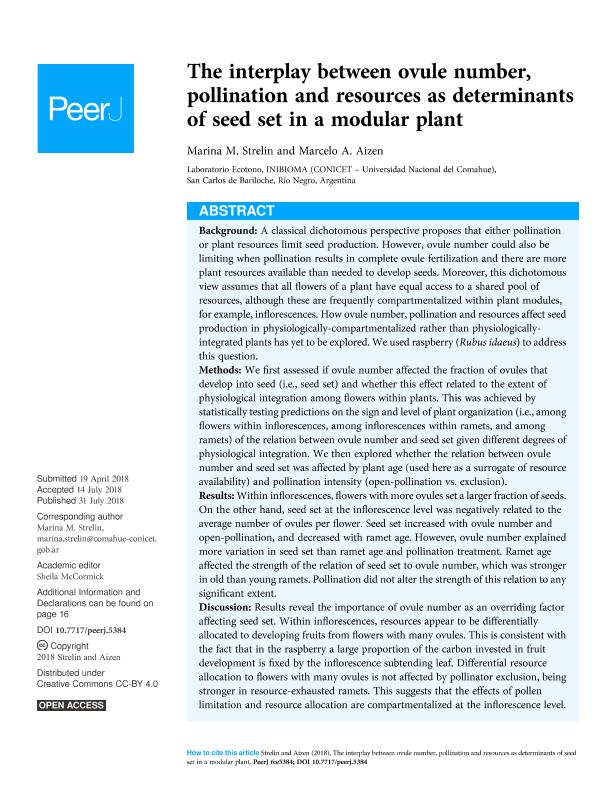Artículo
The interplay between ovule number, pollination and resources as determinants of seed set in a modular plant
Fecha de publicación:
31/07/2018
Editorial:
PeerJ
Revista:
PeerJ
ISSN:
2167-8359
Idioma:
Inglés
Tipo de recurso:
Artículo publicado
Clasificación temática:
Resumen
Background. A classical dichotomous perspective proposes that either pollination or plant resources limit seed production. However, ovule number could also be limiting when pollination results in complete ovule fertilization and there are more plant resources available than needed to develop seeds. Moreover, this dichotomous view assumes that all flowers of a plant have equal access to a shared pool of resources, although these are frequently compartmentalized within plant modules, e.g. inflorescences. How ovule number, pollination and resources affect seed production in physiologicallycompartmentalized rather than physiologically-integrated plants has yet to be explored. We used raspberry (Rubus idaeus) to address this question.Methods. We first assessed if ovule number affected the fraction of ovules that develop into seed (i.e. seed set) and whether this effect related to the extent of physiological integration among flowers within plants. This was achieved by statistically testing predictions on the sign and level of plant organization (i.e. among flowers within inflorescences, among inflorescences within ramets, and among ramets) of the relation between ovule number and seed set given different degrees of physiological integration. We then explored whether the relation between ovule number and seed set was affected by plant age (used here as a surrogate of resource availability) and pollination intensity (open pollination vs. exclusion).Results. Within inflorescences, flowers with more ovules set a larger fraction of seeds. On the other hand, seed set at the inflorescence level was negatively related to the average number of ovules per flower. Seed set increased with ovule number and open-pollination, and decreased with ramet age. However, ovule number explained more variation in seed set than ramet age and pollination treatment. Ramet age affected the strength of the relation of seed set to ovule number, which was stronger in old than young ramets. Pollination did not alter the strength of this relation to any significant extent.Discussion. Results reveal the importance of ovule number as an overriding factor affecting seed set. Within inflorescences, resources appear to be differentially allocated to developing fruits from flowers with many ovules. This is consistent with the fact that in raspberry a large proportion of the carbon invested in fruit development is fixed by the inflorescence subtending leaf. Differential resource allocation to flowers with many ovules is not affected by pollinator exclusion, being stronger in resourceexhausted ramets. This suggests that the effects of pollen limitation and resource allocation are compartmentalized at the inflorescence level. Consequently, modular plants can be viewed as reproductive mosaics where either ovule number, pollination or resources limit the number of seeds set by different flowers, so that improvements in any of them could increase plant seed production.
Archivos asociados
Licencia
Identificadores
Colecciones
Articulos(INIBIOMA)
Articulos de INST. DE INVEST.EN BIODIVERSIDAD Y MEDIOAMBIENTE
Articulos de INST. DE INVEST.EN BIODIVERSIDAD Y MEDIOAMBIENTE
Citación
Strelin, Marina Micaela; Aizen, Marcelo Adrian; The interplay between ovule number, pollination and resources as determinants of seed set in a modular plant; PeerJ; PeerJ; 31-7-2018
Compartir
Altmétricas




